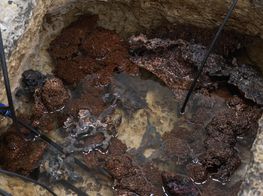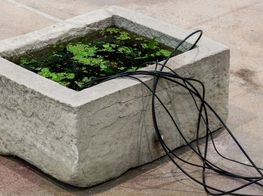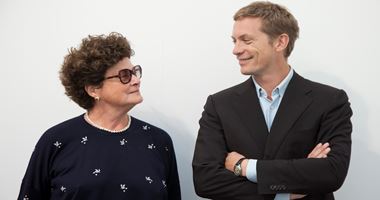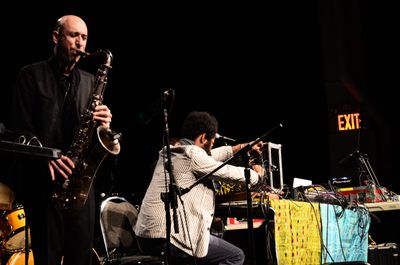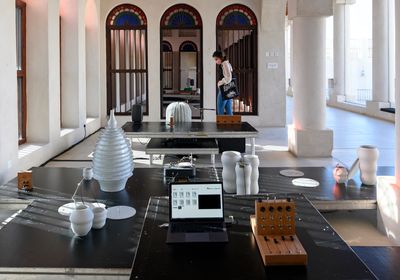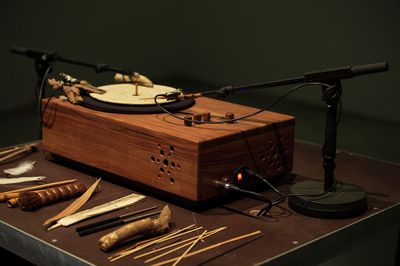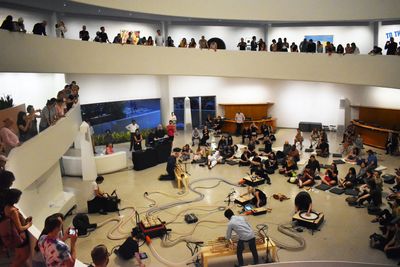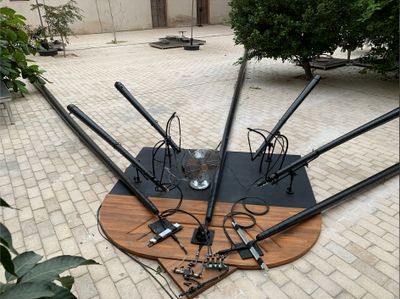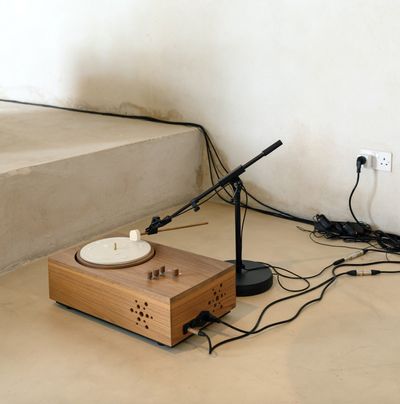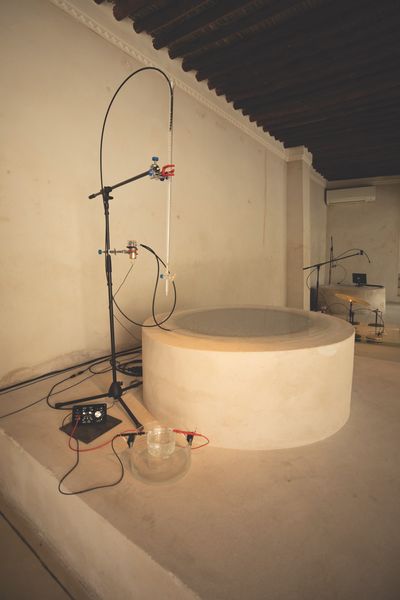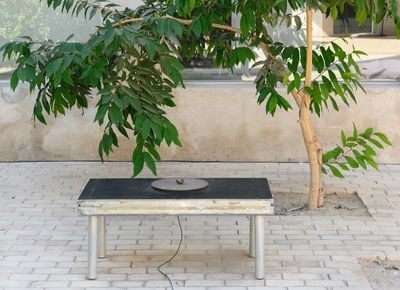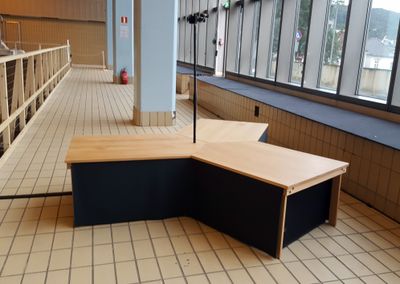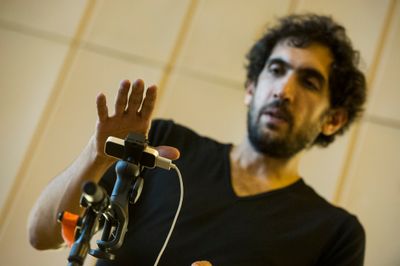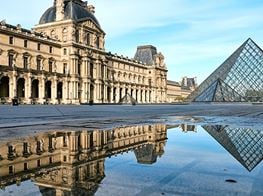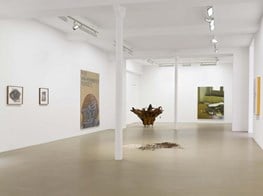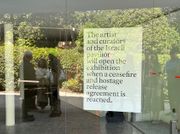Tarek Atoui’s Sonic Environments
Performance view: Tarek Atoui, I/E Elefsina, Aisxylia Festival, Elefsina (2015). Courtesy the artist and Galerie Chantal Crousel, Paris.
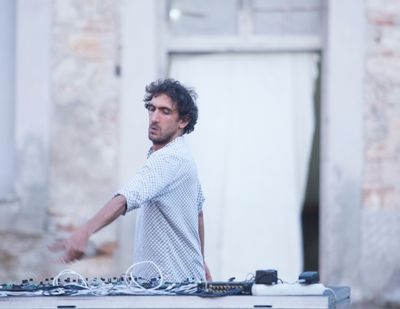
Performance view: Tarek Atoui, I/E Elefsina, Aisxylia Festival, Elefsina (2015). Courtesy the artist and Galerie Chantal Crousel, Paris.
In Tarek Atoui's totalising sonic environments, space, architectures, bodies, and instruments can be both conductors and receptors of sound. The innovative Beirut-born, Paris-based sound artist and composer builds and instrumentalises sonorous objects, materials, and physicality, which resonate in collective compositions and generate different acoustic landscapes.
At the moment, Cycles in 11 at the Sharjah Art Foundation (SAF) (26 September 2020–10 April 2021) spans 11 years of his practice and collaborations in Sharjah, especially his work around deaf culture, which originated with the project WITHIN (2013). Growing out of a 2008 SAF residency, WITHIN became foundational to the ways in which Atoui studies the perception of sound by the hard of hearing and nuanced perspectives towards listening.
His corresponding examinations of how sound performs in space has led to a transdisciplinary network of musicians, researchers, and instrument-makers who have built musical devices that are accessible to all degrees of hearing.
Sharjah is also where Atoui's gallerist Chantal Crousel first encountered his work in 2011, during Visiting Tarab, a Performa 11 commission with SAF, which drew from the world's largest repository of classical Arabic music by Lebanese collector Kamal Kassar.
Moving from one archive to another, Atoui is in the process of building another sonic library, recording and sampling sounds at harbours and inside military bases, fish markets, and oil tanks around the world in the I/E project (2013–ongoing), a new iteration of which is in Kassel for his first solo exhibition in Germany at the Fridericianum, Waters' Witness (3 October 2020–28 March 2021). The recordings, stored in the form of 'sound boxes', reflect changing audio palettes that echo their underwater and industrial contexts, and translate into distinct material and spatial considerations.
In his sonic ecologies and propositions, Atoui abstracts, embeds, and embodies sound in transitory forms, shifting roles between researcher, programmer, composer, performer, and collaborator, often inviting others to intervene. His oeuvre sits at the cusp of redefining the language of visual and performing arts and challenging contemporary sound production. The aural becomes a catalyst in situating our relationship to time, presence, and space as he investigates and experiments with the thresholds of audibility, amplification, and accessibility.
Atoui's output contests traditional hierarchies of perception and modes of listening, positing an all-encompassing, fluid vision that connects instrumentation to bodies and gestures toward hearing movement. His accomplishments, which have taken him from the Sharjah Biennial (2009, 2013) to documenta in Kassel (2012), the Berlin Biennale (2014), and Venice Biennale (2019), have earned him the 2022 Suzanne Deal Booth / FLAG Art Foundation Prize, with USD $200,000 and production expenses covered for an upcoming solo exhibition at The Contemporary Austin's Jones Center in Texas and the FLAG Art Foundation in New York.
Upcoming projects include his participation in the 13th Gwangju Biennale (1 April–9 May 2021), the 50th edition of the Darmstadt Summer Course (31 July–14 August 2021), and Struer Tracks, a sound art festival taking place between 20 August and 5 September 2021 in Denmark.
In this conversation, Atoui discusses his experimental practice in sound.
NKFirst of all, congratulations for the FLAG Art Foundation Prize. Do you know what you will do for it?
TAI have an idea. I'm looking at the different audiences and people I've worked with in the past as components of the work, reaching out to music students, associations for the deaf, and a whole array of people with varying degrees of expertise.
The challenge is to have them work together in interesting ways. What I want to do, especially given the current circumstances, is create a collective work that stems from both studio and performance processes. I want to first open a laboratory for researching sound practices that can be activated as a residency or workshop space. An exhibition will be born from this laboratory, as well as an on-site performance programme.
NKDo you think virtual practices are something artists have to do more and more these days?
TAWhile I'm trying to initiate these remote studios to which I send instruments, sound objects, and ideas, and work with people there, I'm still advocating for the opportunity to meet in a space and work together.
Even a small plastic cup is a space you can play and record sound in. You can broadcast a whole installation in it. I feel at ease in architectural space, because sound has this ability to travel and occupy it.
NKYou often talk about bridging the worlds of music and art. What was the definitive moment that launched you into the field of contemporary art? Did it start with your relationship with the Sharjah Art Foundation?
TAIt's not something that just suddenly happened. It occurred progressively, in that I always had an interest in the art world and its practices. There were several encounters with artists like Lamia Joreige, who I was a software developer for. But I think Sharjah represented the moment when I received a substantial art residency, invited by Jack Persekian after our encounter in Amsterdam in 2008.
NKI remember seeing you play in Beirut's underground venues in the late 1990s. Did you ever think you would become an artist?
TAI knew that my studies in economics and cultural management was not the path I was going to follow, but it took me some time to find out what this would be. Even though I realised it would be linked to music and sound, I wasn't sure what aspect of the field it would be in. Was it going to be composition for dance? Theatre? Film? Touring with bands?
After one album release, I realised I wasn't interested in the latter. And little by little, I transitioned into making sound, which I found I cherished the most.
NKWhen did you first get into sound performance?
TAI started in France around the year 2000. I was DJing in techno music at the time.
NKA lot of your performances are improvisational, where you co-create with others. Although you incorporate technological tools, you often activate handmade instruments in performance. How fundamental is programming to your language, allowing this interaction to occur?
TAIt's a great tool, and one that I still use both conceptually and practically. When it comes to activating my compositions, programming is a tool that I'm in control of and can employ like a meta-instrument, in how it can structure a research process and bring something mathematical in.
NKEven your instruments are open work, disassembled and reassembled in sound. What led you to handmade apparatuses?
TAThe idea of the material took me to craft. Thinking about the sound of ceramics led me to work with ceramicists.
NKYour work looks at the body as a vessel of resonance, but also considers the machine as a body, such as with the 'Un-drum' series (2009–2010). How would you formulate this relationship between the body and the machine?
TAUn-drum / strategies for surviving noise (2009) was the first time I built this machine. It set up the cornerstone of my relationship to instruments, as well as to gesture in performance in ways that still echo today—all that changes is the medium and the ways in which things are built.
I moved from work that was digital in nature and that could be done by myself to compositions that call upon the craft or know-how of specialists. Yet the logic of putting things together, like building an instrument's software, is still the way I create a score with several improvisers.
The 'Un-drum' series included ideas like blowing up the surface of a small digital controller, the MIDI, and magnifying certain gestures to make them absurd or impossible to execute in relation to notions of virtuosity in the classical form. These are still present in my work, and you can see inversions and distortions of these notions in acoustic instruments that are no longer computer-based or digital.
NKDo you think you would have been this subversive in sound if you were trained in classical music?
TAThere are people who are trained classically who are similarly disruptive but still have a significant technical mastery, to which a conceptual layer is added. In my case, I don't have this virtuosity.
From an early stage, I didn't propose rhythms or structures when I interacted with musicians, who came from jazz or classical music backgrounds, for example. I only had concepts or abstract ideas to put on the table.
I like the idea of releasing the potentiality of a space by not erecting walls. In many of my works, the spaces are totally open, connecting with the outside as much as possible.
NKThere still seems to be an urge for you to break a boundary, whether it's sonic or perceptual. Where does this drive come from?
TAIt's really coming from an awareness of what was established before me, of understanding the history behind sound practices, and growing up in an artistic environment that was very rigorous and therefore not easily satisfied. There's always an attempt to push things further and ask yourself the question of what lies beyond this point, or how it can be done differently.
NKGoing back to 'Un-drum', tell us about the second one in the series: the Chinese connection (2009), and how it compared the cultural shift during the Maoist Communist revolution to the pan-Arab movements in the ways it created a new mythology of modern art forms and social change.
TAIt was a specific commission from Jack Persekian for an exhibition called Disorientation II: The Rise and Fall of Arab Cities (21 November 2009–20 February 2010), which was about the fall of the Pan-Arab movement and my contribution to this was to kind of skip that debate and instead, look at how it compared with the Chinese Cultural Revolution.
NKIs it true that you have lost some of your hearing due to a detainment in Lebanon? And do you think that's what led you to working with deaf people?
TAI think that's a simplification, although I have read it in the press. 'Un-drum' functioned as a process of healing in order to move away from that, and it's honestly not that intense. I feel the difference between my ears sometimes when I'm tired or stressed, but otherwise, I'm not suffering from it.
NKDo you distinguish the act of listening from hearing? In much of your work, these are simultaneous processes and listening becomes active.
TABoth can be part of the same world. Hearing is a form of listening. There's this exercise of returning to an unconscious state of listening, which is something similar to naïve listening—when you listen to music and you don't know who's doing what within the piece. You don't distinguish the instruments from each other, you just listen to the ensemble as a whole.
NKNow that you're back at the Sharjah Art Foundation with Cycles in 11, much of this show relates to durational facets marking over a decade of collaborative work. Can you say more about the work Pulses in 11 (2020)?
TAPulses in 11 forms part of the introduction to the show. It's this idea of the metronome that punctuates the space when you enter it, where there's a corridor on the right with all these stones that are acting more like mega-frenetic metronomes.
NKThey look like contraptions driven by water. Why did you incorporate water?
TABecause of the organic quality of the water drop, like sand in the hourglass. There's an inexactitude to water, which takes time to fall, and is affected by its environment.
Different notions of metronomes were combined together, such as the strict, digital metronome of the computer. Then you had a disc in ceramic that was rotating to the rhythm of 11.
NKWhy is 11 significant?
TAIt's a time signature or rhythmic cycle in Arabic music.
NKSo time becomes abstract if there's no linearity to it.
TAThe rhythm is not regular at all. There's a structure that propels the water to drop, but then the drop happens in a very irregular way. Sometimes it drops in one second and sometimes in ten, so yes, there's an abstraction to it.
NKSound is then both elemental, as part of nature, and psychoacoustic or manipulable. You seem to blur the lines between instrumentation and materiality, using the material as an instrument by permuting an electric current through it. Can the body also be seen as a responsive conductor or machine?
TAMaybe it's an augmented body—an organism that is heightened by technology—but I wouldn't say that it becomes mechanic or machinic through this augmentation. The machine is not a substitute to the body you see, or at least this doesn't form my relationship to technology.
Silence is complex; it's more a state of mind or an inner disposition than an absence.
NKYou have a very intuitive way of working with space in your installations. How significant is the space around the sound, through which sound migrates?
TAEven a small plastic cup is a space you can play and record sound in. You can broadcast a whole installation in it. I feel at ease in architectural space, because sound has this ability to travel and occupy it.
I like the idea of releasing the potentiality of a space by not erecting walls. In many of my works, the spaces are totally open, connecting with the outside as much as possible. I'm not saying that the space is always an instrument necessarily. There are cases when spaces are and others when they aren't. Prehistorical caves, for example, were set up according to resonance, and where people felt comfortable in terms of sound.
NKDo you think we have enough words to describe sound?
TANot really, especially not in sign language.
NKDo you see with your ears?
TAYes.
NKYou've often said that the human voice occupies a very narrow range of frequency, which you've learned from those who cannot hear it. The monumental bass synthesiser, Zero Point Nine, which you developed at a residency with the Berkeley Art Museum and Pacific Film Archive, works with subsonic sounds that produce ultra-low-frequency electronic sounds that are felt before they are heard.
TAYes, it is an instrument that was made during my research with deaf communities, in collaboration with Meyer Sound, which manufactures subwoofers. The idea was to come up with a language similar to sign language—a system that would translate finger movements into bass frequencies. These are gestures that are familiar to deaf people who are very skilled at using their fingers.
NKAs a mode of communicating?
TAYes, the movements and the bass frequencies become a system of communication combined. Although it's a very technical instrument, it's also very intuitive, in that anyone moving their hands or fingers would immediately get a result. So you can bypass the technicality by just standing on it and moving your hands.
NKAre sound and silence binary? And what is silence in sonic terms?
TAThey aren't, but this is a tough question. Silence is complex; it's more a state of mind or an inner disposition than an absence.
NKThe Reverse Collection (2016) is intriguing from an anthropological point of view. You began with ancient instruments you were given permission to record, which were played to instrument-makers who engineered new objects that produced the same sounds according to their interpretations.
TAI was concerned with how objects, shapes, and functions could change with oral transmission. The experiment was conducted with about a dozen instrument-makers from all over the world, to see what they would imagine without an awareness of the actual instruments behind the recordings I was sharing with them, from Berlin's Ethnological Museum.
NKYour other site-specific work has been quite different, such as your field research in China's Pearl River Delta for The Ground (2018), first presented at Mirrored Gardens in Guangzhou. Why did you decide to focus on elements of agriculture and architecture for these instruments, also made in collaboration with craftsmen and electronic engineers?
TAIt came from observing a very unique urban topology around 2010, when Guangzhou was progressively expanding and agricultural practices were starting to get entrapped between building blocks and rapidly growing urbanscapes. From there, I started looking closer into how people were producing in this context.
NKYour work I/E (2013–ongoing), on the other hand, takes different ports—Abu Dhabi, Athens, Singapore, Porto, Beirut—as points of departure. It functions as an aggregation or assemblage—some people have called it a sound library. It's the first time you seem to be collecting and trapping sound inside material, instead of diffusing or disseminating it. What are you going to do with all of these sounds?
TAI'm still in the process of collecting. The question of what happens to this library of sounds becomes more important when you consider that I recorded in Beirut a few months before the explosion. Hopefully I will have the answers after a few more cities. Now I'm aiming for the big harbours in Europe, like Antwerp or Hamburg.
NKHow significant are field recordings, and the need to be inside environments, especially in terms of electronic music?
TAField recordings and electronic sound were all part of the same education and vocabulary for me. Electroacoustic music is very much interested in this idea of a sonic object—as seen in Pierre Schaeffer's objets sonores—which in the early stages was a field recording.
NKWhat is the residue of sound? What is left behind?
TAIt's something very personal, but also totally unpredictable in terms of its impact and interpretation. It could be that you visit my pieces and you're left with a memory of falling off your bike for the first time, for example. Sound can bring you back to something that is very intimate. —[O]

